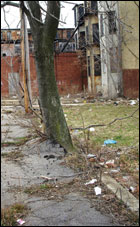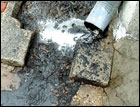By Jessica Smits

|

|
|

|
||
|
A mix of matter — grass, leaves, and everything in between — litters this West Baltimore alley. As gutters and rainspouts empty onto streets and alleyways, this organic debris begins its journey toward the Patapsco River. Ken Belt (above) and Sujay Kaushal have teamed up to study the effects of organic matter as it washes from the urban ecosystem downstream to the river and the Bay. Left and upper right photographs by Ken Belt and the lower right photography by Erica Goldman.
|
||
When Ken Belt looks around West Baltimore on rainy days, he sees streams everywhere. A strange thing, since streams in this part of the city went underground long ago to make way for streets, parking lots, rowhouses, and storefronts. Belt's not imagining things. He just looks at the situation a bit differently than most.
For Belt, a hydrologist and professional engineer with the United States Forest Service, each gush of water that runs down a street and into a storm drain is a headwater stream, a small waterway that eventually joins others to form larger streams. If underground pipes are branches of a tree, he says, then these street-level "streams" are twigs. Belt estimates that every city block has at least two connections to the drain, meaning that hundreds of these "zero order" streams cover urban neighborhoods. When he counts these untraditional streams, he sees an exponential increase in the number of tributaries.
Storm drains are designed to get water off the landscape as quickly as possible, Belt explains. It's a design that appears to work too well in Watershed 263, a hydrologic basin in West Baltimore that flows entirely through storm drains (see Greening Gray Streets). This subterranean watercourse is the product of what Belt feels was less enlightened engineering in a previous era. With nearly three-quarters of the watershed covered by impervious surfaces like roads and parking lots, few grassy areas remain to absorb the flow. During a storm, torrents of rainwater flow from gutters, driveways, and roads, picking up leaves, dust, dirt, and trash — what Belt calls "schmutz" — along the way. This schmutz can make its way into storm drains and ultimately through the outfall pipe into the Patapsco River, a tributary of the Chesapeake Bay.
The components of storm flow — especially organic matter — have grabbed Belt's attention. With carbon as its backbone, organic matter forms the base of the food web and supports all life on earth. In both its dissolved and particulate forms, organic matter plays an important role in traditional stream ecology. Bits of leaves, algae, and debris serve as food for microorganisms, including those that take up nitrogen and phosphorus — nutrients frequently blamed for poor water quality throughout the Bay and its watershed.
But organic matter has downsides too. Its decomposition can suck up oxygen and lead to hypoxia in aquatic ecosystems. The Chesapeake experiences this nearly every summer when vast swaths of algae die and decompose, creating low or no oxygen zones. Organic matter is also described as chemically "sticky" because it can bind tightly to metals and toxic compounds, including carcinogenic polyaromatic hydrocarbons (PAHs), pesticides, and flame retardants.
Belt thinks leaves and other debris that get washed into storm drains may be loading urban stormwater with organic matter. While leaves are part of natural stream ecology, urban areas don't have the natural landscape characteristics that allow leaves and other organic matter to decompose — helping to form soil, for example. In an urban landscape, leaves and other woody debris, along with chemicals and trash, wash directly into storm drains and into the Bay.
All this adds up to what Belt calls the "gutter subsidy," the idea that a city's vast network of storm drains provides a sometimes forgotten pathway for organic material. It's an urban myth that urban streams are devoid of organic matter, Belt feels. Curious to find out whether organic matter entering storm drains has ecological effects, he approached his friend and colleague Sujay Kaushal at the University of Maryland Center for Environmental Science.
As a biogeochemist, Kaushal's first instinct was to suggest that he and Belt study the chemistry of the water to determine the amounts and sources of organic carbon present. The project became part of the Baltimore Ecosystem Study, a long-term effort to better understand the city's urban environment.
Belt, Kaushal, and their team collect water samples at thirteen study sites ranging from 100-percent forested in Baltimore County's Pond Branch to 75 percent impervious surface-covered in Watershed 263. Belt uses innovative sampling techniques to study transport along gutters, inside underground storm drains, and along streams, while Kaushal analyzes the chemistry of the water. Using instruments from handmade sieves to state-of-the-art automated samplers, they record measurements at one-to-two-week intervals and throughout storm events.
One indicator of the abundance of organic matter, Kaushal says, is oxygen consumption. As microbes decompose organic material, they use up oxygen. Data from Watershed 263 show the highest oxygen demand of all the sites, especially during storm events.
Kaushal suspects this is because the high percentage of impervious surface cover in Watershed 263 allows organic matter-laden water to wash into storm drains efficiently and quickly. The drains act like huge funnels, he says, collecting and concentrating organic matter. "It's coming in at a much faster rate than organisms can take it up or remove it." Efforts to add more green space in the watershed could help slow the flow. Landscaping features like grassy medians and rain gardens act like sponges, soaking up water before it can reach the drain.
From their work so far, Kaushal says, they've found there's a significant amount of organic matter coming into these urban streams. But it's a cocktail, a mix of compounds. Their next steps will entail confirming the matter's exact source and make-up and studying what its presence means for the ecosystem. Recent funding from the National Science Foundation and the Chesapeake Bay Program will help them crack this chemical recipe for organic matter in urban streams.
It's work that could have implications for the larger Bay restoration effort, Kaushal says. Their research may ultimately "link up what happens in the storm drain down to the Chesapeake Bay."
Because of its ability to bind toxic chemicals and deplete oxygen, organic loading deserves more attention, Kaushal believes. "Nitrogen and phosphorus are the elements that people talk about, but ultimately it's organic matter that does all the damage."
![[Maryland Sea Grant]](/GIFs/h_footer_mdsg.gif)